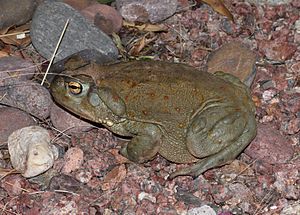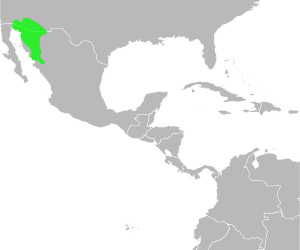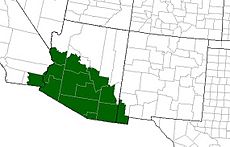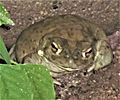Colorado River toad facts for kids
Quick facts for kids Colorado River toad |
|
|---|---|
 |
|
 |
|
| Conservation status | |
| Scientific classification | |
| Genus: |
Incilius
|
| Species: |
alvarius
|
 |
|
| Synonyms | |
|
Ollotis alvaria (Frost, 2006) |
|
The Colorado River toad (Incilius alvarius), also known as the Sonoran Desert toad, is found in northern Mexico and the southwestern United States.
Description
The Colorado River toad can grow to about 190 millimetres (7.5 in) long and is the largest toad in the United States apart from the non-native cane toad (Rhinella marina). It has a smooth, leathery skin and is olive green or mottled brown in color. Just behind the large golden eye with horizontal pupil is a bulging kidney-shaped parotoid gland. Below this is a large circular pale green area which is the tympanum or ear drum. By the corner of the mouth there is a white wart and there are white glands on the legs. All these glands produce toxic secretions. Its call is described as, “a weak, low-pitched toot, lasting less than a second.”
Dogs that have attacked toads have suffered paralysis or even death. Raccoons have learned to pull a toad away from a pond by the back leg, turn it on its back and start feeding on its belly, a strategy that keeps the raccoon well away from the poison glands. Unlike other vertebrates, this amphibian obtains water mostly by osmotic absorption across its abdomen. Toads in the family bufonidae have a region of skin known as "the seat patch", which extends from mid abdomen to the hind legs and is specialized for rapid rehydration. Most of the rehydration is done through absorption of water from small pools or wet objects.
Distribution and habitat
The Colorado River toad is found in the lower Colorado River and the Gila River catchment areas, in southeastern California, New Mexico, Mexico and much of southern Arizona. It lives in both desert and semi-arid areas throughout its range. It is semiaquatic and is often found in streams, near springs, in canals and drainage ditches, and under water troughs. The Colorado River toad is known to breed in artificial water bodies (e.g., flood control impoundments, reservoirs) and as a result, the distributions and breeding habitats of these species may have been recently altered in south central Arizona. It often makes its home in rodent burrows and is nocturnal.
Biology
The Colorado River toad is sympatric with the spadefoot toad (Scaphiopus spp.), Great Plains toad (Anaxyrus cognatus), red-spotted toad (Anaxyrus punctatus), and Woodhouse's toad (Anaxyrus woodhousei). Like many other toads, they are active foragers and feed on invertebrates, lizards, small mammals, and amphibians. The most active season for toads is May–September, due to greater rainfalls (needed for breeding purposes). The age of I. alvarius individual in a population at Adobe Dam in Maricopa County, Arizona ranged from 2 to 4 years; other species of toads have a lifespan of 4 to 5 years. The taxonomic affinities of I. alvarius remain unclear, but immunologically, it is similarly close to the boreas and valliceps groups.
Breeding
The breeding season starts in May, when the rainy season begins, and can last up to August. Normally, 1–3 days after the rain is when toads begin to lay eggs in ponds, slow-moving streams, temporary pools or man-made structures that hold water. Eggs are 1.6 mm in diameter, 5–7 cm apart, and encased in a long single tube of jelly with a loose but distinct outline. The female toad can lay up to 8,000 eggs.
Images for kids
See also
 In Spanish: Sapo del desierto sonorense para niños
In Spanish: Sapo del desierto sonorense para niños




